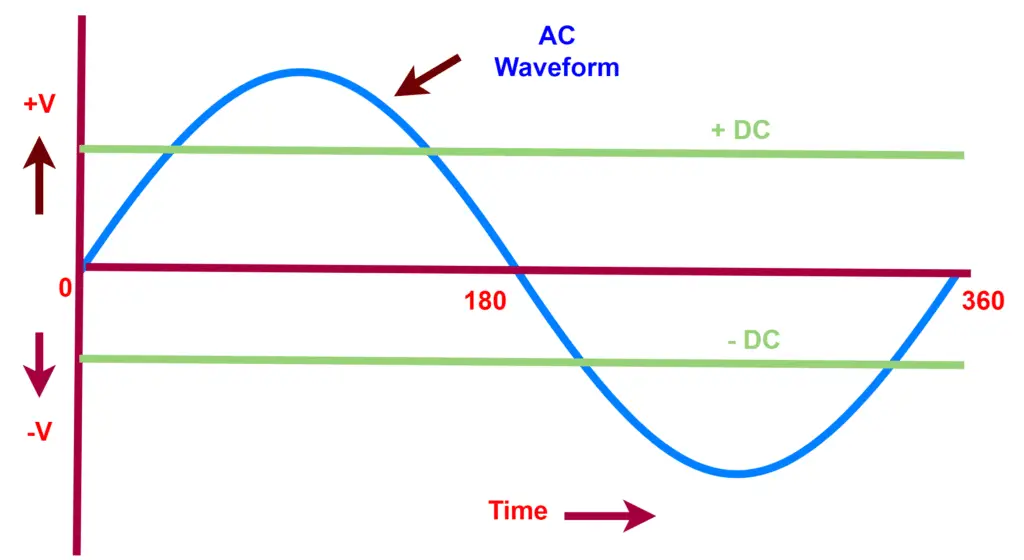There are two types of voltage sources used in an electric circuit viz. AC source and DC source and electric power can be classified into two types- AC power and DC power.
We can define power as the rate of energy consumed in a unit of time. In other words, the rate of doing work in a given time is called power. The power is measured in Watts, and the unit is named after James Watt who invented the steam engine. The steam engine power is a mechanical power and it is a combination of force and movement.
Similarly to mechanical power, electrical power is the rate of flow of electrical energy at a given time in a closed circuit. The closed circuit cause current to flow through it.
There are two types of electric power, one is AC power and the other one is Direct Current (DC) power. A closed electrical circuit consumes power only if the voltage is applied. On application of voltage to an electric circuit, the current starts flowing, and the nature of the current depends on the nature of the voltage. If the voltage is DC, then the current will be DC, and if the voltage is AC, then the current will be AC. The difference between AC and DC is that DC (Direct current) does not reverse the polarity and we can say it is unidirectional. Whereas, AC is an alternating current that reverses its polarity after a certain time.
In a nutshell, we can say DC does not have frequency and its frequency is zero. AC has a frequency, AC frequency is 50 Hz or 60 Hz. Waveforms of AC and DC are given below.

Frequency of AC Power
The electrical charge travels in both directions in a time period. This time period is called one cycle. The process of moving forward and backward depends on the frequency and if the frequency is very high or the time period is very less, the moving charges move in forward and reverse directions very fast.
The electrical current complete many cycles in one second. The number of cycles completed by electric current in one second is called frequency. The frequency in North American countries is 60 Hz, which means the electric current completes 60 cycles in one second. In many other countries, the AC frequency is 50 Hz.
Calculation of AC Power
If we feed DC voltage to a circuit, then it will consume DC power. The formula of DC power is;

Now, if we feed AC to an electric circuit, then it will consume AC power. Do you think, the formula for calculating AC power is the same as that of DC power? The answer may be Yes or No. In an AC circuit the current depends on the phase angle between voltage and current. The phase difference between the voltage and current is called the power factor.
The AC power formula is;

Here, voltage and current values are RMS values.
If the electrical load is resistive in nature, then the voltage and current will be in phase, and the power factor is unity. Then the AC power is;

Therefore, the formula of AC and DC power is the same for resistive loads. However, for inductive and capacitive loads the formula of AC power is different because the voltage and current are not in phase for these types of loads.
The phase relationship between voltage and current is very important for the calculation of AC power. If the current flowing in the circuit has no phase difference with applied voltage, the circuit is resistive and the power consumed by the circuit is active power or AC power or real power. The apparent power and the reactive power are zero.
The AC power in a single-phase AC circuit can be expressed by the following formula.

The AC power in a three-phase AC circuit can be expressed by the following formula.

Advantages of Alternating Power
One of the major advantages of the use of AC power is that it is very easy to change the voltage level. The transformer is used to change the voltage levels which function on the AC supply. It can not function on DC supply.
The AC power is normally generated at 11kV. If we use the same voltage for transmission, then there will be enormous losses because of the high current. Therefore, for long-distance transmission, the voltage is first boosted to a high value using a step-up transformer, and therefore the current lowers in the same proportion to the increased voltage.
Now, with the use of AC power, it is possible to transmit the same amount of power at a lower current and the transmission losses reduce and efficiency improves. Moreover, voltage regulation improves.